The most attractive smile according to Tunisian orthodontists, dentists and laypersons
Gestion de l’anomalie de forme dentaire chez l’enfant : à propos d’un cas clinique.
14 février 2021The management of a gummy smile without surgery, about a case report
23 février 2021The most attractive smile according to Tunisian orthodontists, dentists and laypersons
Rim Ben Elkahla, Hiba Gmati , Mariem Nasfi, Mounira Rtibi ,PR Abdelatif Boughzala Pr Anissa Elyemni Zinelabidine
Abstract:
Objective: The main objective of this study was to evaluate the perceptions of different groups of evaluators (orthodontists, dentists and laypersons) regarding some modifications to the components of a woman’s smile. Materials and methods: 220 Tunisians (38 orthodontists, 95dentists and 87 laypersons) assessed the esthetics of 21 altered picture of the same smile arranged at random. The manipulated components (maxillary dental midline, inter-incisor diastema, crown width of the lateral incisor, crown length of central incisor and gingival exposure) were altered using Adobe Photoshop CS6 software. To assess the attractiveness of the pictures, a score from 1 to 10 was given by different evaluators. The response were then analyzed and processed with SPSS software version 17.0 using the Kriskal Wallis Test and the Mann Whitney Test. Results: the three groups had a different perception of attractiveness when evaluating the modified features. Orthodontists were more critical when evaluating the different smiles. Medline shift and lateral crown width were the least perceptible unlike the Medline diastema and central crown length. Age, gender and years of dental practice showed no signification correlation with the attributed scores, contrary to the educational level.
- Introduction
The smile is an integral part of the face and, more generally of the whole person and is considered fundamental in facial esthetics; it expresses beauty, age, personality and youth and it’s the easiest expression to recognize, used to convey to other human beings a sense of compassion and understanding.
- Subjects and methods
2.1Subjects:
The study sample comprised 220 persons divided into 3 groups: 38 orthodontists (17.3%), 95 general dentists (43.2 %), 87 laypersons (39.5%), aged between 19 and 66 years (mean: 32.68 with SD: 8.43), 35 % men and 65% women.
The lay group consisted of teachers, engineers, nurses, farmers, housewives, unemployed people and others without any dental backgrounds.
2.2Variables and measurements:
Twenty-one modified photographs of young white woman’s smile were used in this study. The photographs showed the smile alone, excluding other facial structures, to minimize any distracting variables.
The smile features in the photographs were digitally altered by Adobe Photoshop CS6 software (Adobe Systems Inc., San Jose, CA).
The alterations were intentionally created to resemble a smile aesthetic discrepancy. The photographs were grouped into five sets, each representing an altered smile feature, with alteration increments ranging from 0.5 to 1 mm. The altered features were as follows: (1) Crown length of the central incisor, (2) Crown width of the lateral incisor, (3) gingival exposure, (4) maxillary midline shift, and (5) midline diastema.
All five alterations were selected after consulting with clinically experienced orthodontists and general dentists and were chosen based on their frequency and clinical significance in esthetic planning.
The photographs were coded for identification with one letter and one number such as ‘A2’, ‘E4’ and were grouped randomly .
2.2.1Crown length of the central incisor
The crown length of the maxillary left central incisor was shortened in 0.5 mm increment then in 1 mm increments by adjusting the level of the gingival margin (Figure1)
2.2.2Crown width of the lateral incisor
Asymmetrical crown width alterations were made to the maxillary right lateral incisor, as the most common tooth, which is affected by the size discrepancy. The incisal edge was kept at the same level. The alteration was limited to the mesio-distal width, which was decreased by 1 mm (Figure 2)
2.2.3 Gingival exposure
These modifications were based on the position of the upper lip relative to the labial gingival margin of the maxillary incisors which was used as reference points for measurements (Figure 3).
The smile was altered by progressively moving the upper lip superiorly 1 mm, 3 mm and 4 mm to create a ‘gummy smile’ or inferiorly -3 mm to create low smile.
2.2.4 Maxillary midline shift
A maxillary dental midline deviation toward the right side was made in increments of 1 mm. The cupid’s bow of the upper lip was fixed to present the facial midline as reference (Figure 4).
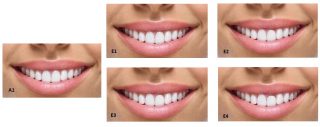
Figure 1: Photographs showing (A1) no alterations and a decrease in the crown length of the maxillary left central incisor by (E1) 0.5 mm, (E2) 1mm, (E3) 2mm, (E4) 3 mm
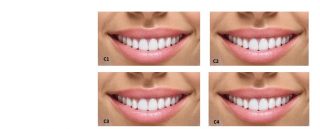
Figure 2: Photographs showing a decrease in the width of the maxillary right lateral incisor by (C1) 1 mm, (C2) 2mm, (C3) 3 mm, (C4) 4 mm
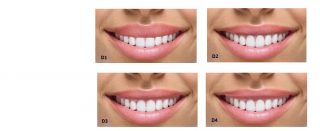
Figure 3: Photographs showing a decrease in the gingival exposition by (D1) -3 mm, and an increase by (D2) 1mm, (D3) 3 mm, (D4)4 mm.
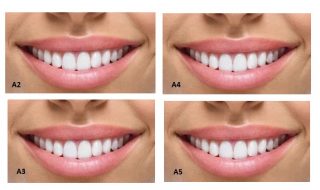
Figure 4: Photographs showing alterations to maxillary dental midline.
(A2) 1 mm deviation, (A3) 2 mm deviation, (A4) 3 mm deviation, (A5) 4 mm deviation
2.2.5 Midline diastema
A midline diastema was created incrementally between the maxillary central incisors by a 0.5 mm then it was increased in 1 mm increments. From the inter- proximal contact points between the central crowns (Figure 5).
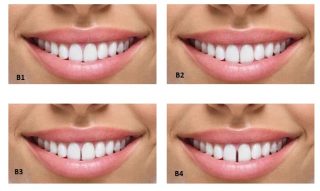
Figure 5: Photographs showing an increase in the maxillary midline diastema by (B1) 0.5 mm, (B2) 1mm, (B3) 2 mm, (B4) 3 mm.
2.3. Survey Form
The survey was wrote out in Arabic language to be more comprehensible and provided to the raters participating in this study allows to collect some personal informations : Age, sex, educational attainment (primary, secondary, university), job (dentist, orthodontist or other), working years for dentists and orthodontists (less than 5 years, between 5 and 10 years, over 10 years) and to give a score from ‘1’ to ’10’ for 21 modified images of smile to assess its attractiveness.
2.4. Smiles classification
Classification of the images was done using a score from 1 to 10, with values over 5 being regarded as esthetic and those below 5 considered unaesthetic. The evaluators were then asked to mark their score next to each image to assess its attractiveness; taking into consideration that 1 meant the least attractive and 10 the most attractive smile.
2.5. Statistical analysis
All the data collected was collected and analyzed using SPSS software version 17.0. Descriptive data are presented as medians and quartiles.
The Kriskal Wallis Test was used not only to identify any difference in perception of altered smile aesthetics between orthodontists, dentists and laypeople, but also to identify any statistically significant differences between educational level, practice years for dentists and orthodontists and the perception of altered smiles.To investigate a possible association between sex, age and the perception towards smile discrepancies, the Mann Whitney was adopted. The significant rate was set at 5 %.
- Results
Orthodontists were more critical and gave lower scores then dentists and laypeople when evaluating different altered smiles.
3.1. Perception following altered maxillary left central incisor crown length
All changes in this parameter showed a statistically significant difference relative to the groups. (Table I)
Table I :Medians comparison of scores attributed to smiles
According to altered maxillary left central incisor crown length and results of Kruskal-Wallis test
| E1 | E2 | E3 | E4 | ||
| orthodontists | median | 6 | 3.5 | 3 | 2.5 |
| First quartile | 4.750 | 2 | 2 | 1 | |
| Third quartile | 7 | 4 | 5 | 3.25 | |
| dentists | Median | 5 | 4 | 4 | 3 |
| First quartile | 4 | 2 | 2 | 1 | |
| Third quartile | 7 | 5 | 5 | 4 | |
| laypeople | Median | 7 | 5 | 5 | 4 |
| First quartile | 5 | 4 | 3 | 2 | |
| Third quartile | 8 | 6 | 6 | 5 | |
| Signification rate | 0.000 | 0.000 | 0.001 | 0.001 | |
3.2. Perception following altered maxillary right lateral incisor crown width
The difference in perception between orthodontists, dentists and laypeople became significant only when right lateral crown width was decreased by at least 2 mm. (Table II)
TableII : Medians comparison of scores attributed to smiles according to
altered maxillary right lateral incisor crown width and results of Kruskal-Wallis test
|
|
C1 | C2 | C3 | C4 | |
| orthodontists | median | 7 | 6 | 6 | 5.5 |
| First quartile | 6 | 5 | 5 | 4 | |
| Third quartile | 8 | 8 | 7 | 6 | |
| dentists | Median | 7 | 6 | 6 | 6 |
| First quartile | 6 | 5 | 5 | 4 | |
| Third quartile | 8 | 8 | 7 | 7 | |
| laypeople | Median | 8 | 7 | 6 | 7 |
| First quartile | 6 | 6 | 5 | 6 | |
| Third quartile | 9 | 8 | 8 | 8 | |
| Signification rate | 0.432 | 0.004 | 0.044 | 0.000 | |
3.3. Perception following altered gingival exposure
The difference between the three groups was not significant at any modification of the gingiva-lip distance. (Table III)
TableIII: Medians comparison of scores attributed to smiles according to the variations of lip to gingiva distance and results of Kruskal-Wallis test
| D1 | D2 | D3 | D4 | ||
| orthodontists | median | 5 | 7 | 6 | 5 |
| First quartile | 4 | 5.7 | 4.7 | 3 | |
| Third quartile | 7 | 8 | 7 | 6 | |
| dentists | Median | 5 | 8 | 6 | 6 |
| First quartile | 4 | 6 | 4 | 4 | |
| Third quartile | 8 | 8 | 6 | 7 | |
| laypeople | Median | 5 | 8 | 6 | 6 |
| First quartile | 4 | 6 | 4 | 4 | |
| Third quartile | 8 | 9 | 8 | 7 | |
| Signification rate | 0.085 | 0.364 | 0.940 | 0.084 | |
3.4 Perception following altered Maxillary dental midline shift
The difference in perception between the three groups was not significant with any modification of the dental midline deviation.
The dentist and the layperson group were less critical and rated all smiles at the same as the ideal one. They could not detect a midline deviation even when we shifted the dental midline a 4 mm. (Table IV)
TableIV : Medians comparison of scores attributed to smiles according to maxillary dental midline shift and results of Kruskal-Wallis test
| A1 | A2 | A3 | A4 | A5 | ||
| orthodontists | median | 7 | 7.5 | 7 | 6.5 | 6 |
| First quartile | 6 | 6 | 6 | 5 | 5 | |
| Third quartile | 8 | 9 | 8 | 8 | 7 | |
| dentists | Median | 7 | 7 | 7 | 7 | 7 |
| First quartile | 5 | 5 | 6 | 5 | 5 | |
| Third quartile | 8 | 8 | 8 | 8 | 8 | |
| laypeople | Median | 7 | 7 | 8 | 7 | 7 |
| First quartile | 6 | 6 | 6 | 6 | 6 | |
| Third quartile | 8 | 8 | 9 | 8 | 8 | |
| Signification rate | 0.250 | 0.222 | 0.252 | 0.090 | 0.084 | |
3.5. Perception following altered maxillary Midline diastema
All three groups were able to identify a small amount of space between the maxillary central incisors. A smile with a 3 mm diastema (B4) was considered by the three groups as the most unattractive smile in the survey.
There was a significant difference in relation to midline diastema between the groups except for a distance between the central incisors of 0.5 mm. (Table V)
Table V: Medians comparison of scores attributed to smiles according to maxillary midline diastema and results of Kruskal-Wallis test
| B1 | B2 | B3 | B4 | ||
| orthodontists | median | 7 | 6 | 4 | 2 |
| First quartile | 6 | 5 | 3 | 1 | |
| Third quartile | 8 | 7 | 6 | 4 | |
| dentists | Median | 7 | 6 | 5 | 2 |
| First quartile | 5 | 4 | 3 | 1 | |
| Third quartile | 8 | 7 | 6 | 4 | |
| laypeople | Median | 8 | 7 | 5 | 3 |
| First quartile | 6 | 6 | 4 | 1 | |
| Third quartile | 9 | 8 | 7 | 5 | |
| Signification rate | 0.096 | 0.007 | 0.018 | 0.034 | |
3.6. Age, educational level, years of dental practice and altered smile characteristics
As far as the age variable, there was no association with the attributed scores depending on the Mann Whitney test (P >0.05).
Anyhow, the older people gave the highest scores for most of smiles.
Regarding the professional training parameter, the Kruskal-Wallis Test showed a was a statistically significant difference between the educational level and the following smiles: A1, A3, A5, B1, B2, B4, C1, C3, C4, D2, E1 (P<0.05).
The people who had never attend university for study tended to give a higher scores.
Despite the wide range (less than five years to over 10 years), the Kruskal-Wallis Test showed that years of dental practice had no effect on esthetic perception.
- Discussion
In this study, we evaluated the visual perception of smile esthetic discrepancies among Tunisian lay people and dental professionals.it focused on five specific aspects of smile esthetics.
The results confirm that the orthodontists have a different assessment of smile esthetic features compared to that of the dentists and the lay people.
Our sample is made up of 35% of men and 65% of women. This can be explained by the predominance of women in our society.
Regarding the gender parameter, there was no statistically significant difference in our study and the most unaesthetic smile was the one with 3 mm diastema for both sex. However, there was a correlation regarding the gummy smile according to Pinho [1] which the female evaluators found it less attractive. This finding is in contradiction with Paula and al.’s study [2].The difference is probably due to the fact that these authors investigated the self-perception of adolescents concerning exposure of the anterior teeth/malocclusion during smiling. Excessive gingival display is a common feature, especially among females. Therefore, the Gummy smile is not necessarily unaesthetic in the eyes of the public [3].
Concerning the age factor, we divided our simple into two groups using 30 years as a limit. However, no significant correlation was found between the age of the evaluator and the attributed scores.
This is in according with several studies [4–6] that have evaluated esthetic perception in terms of smiles in different age groups. The results of most of them suggested that there were dissimilar perceptions in different age ranges due to evolving attitudes, lifestyles, and opinions. Radically different to Tuzgiray findings [7], age is a factor affecting the perception of smile esthetics. Our study showed that younger individuals aged below 30 years made harsher evaluation of these smiles. This is in according with the study of Lacerda-Santos et al. [8].
Our hypothesis was that orthodontists were more critical and gave lower scores then dentists and laypeople when evaluating different altered smiles and it was confirmed in our study. In additions, it was expected that the smiles containing deviations from the norms would receive significantly lower evaluations. The unattractive smiles are those with 3 mm midline diastema between the maxillary central incisors and with 3 mm decrease of the maxillary left central incisor crown length. Dental specialists need more objective and quantitative data to guide their decisions accurately and to promote better communication with patients when planning treatment that responds to the patient’s needs. Dental specialists seem to be less tolerant in their evaluations, and these differences in perception should be discussed with the patient when planning the treatment to achieve a magnificent and youthful smile.
When modifying the crown length of the maxillary central incisor, the results showed a statistically significant difference in perception between the three groups. Despite those asymmetries of up to 0.5 mm in the free gingival margin seemed to be acceptable and not perceived by the three groups who participated in this study, changes in crown length starting from 1 mm often were noticed by dental professionals or lay people. In these situations, the clinician must decide to treat this problem when it is noticeable so greater than 1mm by various approaches such as periodontal surgeries or orthodontic tooth movement complemented by composite restorations. A benefit of orthodontic tooth movement is that the supporting tissues—bony structure, periodontal ligament, and soft-tissue components—move along with the teeth. Therefore, any intrusive or extrusive tooth movement can be used to obtain gingival margin symmetry without surgery [12].
Tunisian orthodontists and general dentists were able to detect a 4 mm narrowing of lateral incisor crown width, but laypeople did not notice a significant change.
From a restorative standpoint, anterior tooth width is a critical factor for proper denture esthetics [13,14]. The most consistently applied principal is the ‘golden proportion’. One of the first describe the golden proportion and its importance to restorative dentistry was Lambardi [15]. Since then, several others, including, Levin, Brisman [16], and Quatrough and Burk [17], have reinforced its application to anterior esthetics. Kokich applied the rule to orthodontics by describing the proper restauration of peg- shaped lateral incisors in orthodontic patients [14].
The golden proportional value for this tooth is 0.618 or approximately two –thirds the width of adjacent maxillary central incisor.
In our study, the gingiva-to-lip distance was evaluated to determine when a “gummy smile” becomes unattractive from the point of view of Tunisian dental professionals and laypersons. The comparison of their perception showed that the orthodontists were more critical especially when evaluating the smile with a gingival exposure increment of 4 mm.
The image that showed only exposure of the tooth grown and gingival papilla was scored attractive. These results confirm that the gingiva plays a fundamental role in the structural composition of the smile; however, it should not be exposed to an extent exceeding 3 mm.
After all, the increasing distance from gingiva to lip during the smile was not noticeable by the general dental or lay population. Orthodontists were more discriminating. They rated a 4 mm of visible gingiva as excessive and noticeably unattractive.
The low smile revealing only the maxillary incisors, in turn, was scored as the least attractive. This result may be backed by the presence of a low smile line that denotes characteristics of aging.
In our study, the coincidence of the dental and facial midline is not an inevitable condition for the achievement of an aesthetic smile. Indeed, a deviation of less than 4 mm (this which corresponds to a half central incisor) between the facial and dental midline is not noticed by either the patients or the dentists but the orthodontists were more critical about this discrepancy and rated this smile as less attractive.
The lack of perception of dental midline asymmetries by Tunisian laypersons and dentists in our investigation was similar to finding in other studies such as Kokish[9], Pinhos [10], Talic [11].
The three groups were able to identify a small amount of space between the maxillary central incisors so we can say that this type of smile with diastema was the only variation that proved to be a decisive factor in severely compromising the esthetic result. The low acceptability of this factor is perhaps attributable to the esthetic principle broken, which was its unity. A smile that creates a sense of unity is considered more attractive[15,18]. In the other smiles, other principles, such as harmony and balance, were more severely compromised. Perhaps the principle of unity is more important than other esthetic principles [18, 19] in the determination of the attractiveness of a smile in the Tunisian society. Kokich and Rodrigues confirmed this idea and have shown the compromising effect of a smile with diastema as well [9, 12,20].
- Conclusion
Patients may have a different perception of beauty of the smile then the dental professional. Therefore, it is worthwhile to look into their subjective judgments and include their preferences into the treating planning taking in consideration that a small amount of space between the maxillary central incisors and changes in crown length and gingival margin of the central incisor often were noticed by Tunisian population and not acceptable.
References
- Cracel-Nogueira F, Pinho T. Assessment of the perception of smile esthetics by laypersons, dental students and dental practitioners. Int Orthod 2013;11(4):432-44.
- Paula Jr. DF, Silva ET, Campos ACV, Nunez MO, Leles CR. Effect of anterior teeth display during smiling on the self-perceived impacts of malocclusion in adolescents. Angle Orthod 2011;81:540-5.
- Geron S, Atalia W. Influence of sex on the perception of oral and smile esthetics with different gingival display and incisal plane inclination. Angle Orthod 2005; 75(5): 778-84
- Mokhtar HA, Abuljadayel LW, Al-Ali RM, Yousef M. The perception of smile attractiveness among Saudi population. Clin Cosmet Investig Dent 2015; 7: 17-23
- Pithon MM, Bastos GW, Miranda NS, Sampaio T, Ribeiro TP, Nascimento LE, et al. Esthetic perception of black spaces between maxillary central incisors by different age groups. Am J Orthod Dentofacial Orthop 2013; 143(3): 371-5.
- Lacerda-Santos R, Pereira TB, Pithon MM. Esthetic perception of the buccal corridor in different facial types by laypersons of different ages. Biosci J 2015; 31(4): 1283-90.
- Tüzgiray YB, Kaya B. Factors affecting smile esthetics. Turk J Orthod 2013; 26(1): 58-64.
- Lacerda-Santos R, Pereira TB, Pithon MM. Esthetic perception of the buccal corridor in different facial types by laypersons of different ages. Biosci J. 2015;31(4):1283–90.
- Kokich VO, Kiyak HA, Shapiro PA. Comparing the perception of dentist and lay people to altered dental esthetic. J Esthet Dent. 1999;11:311–324.
- Sérgio Pinho , Carolina Ciriaco, Jorge Faber, Marcos A Lenza. Impact of dental asymmetries on the perception of smile esthetics. Am J Orthod Dentofacial.
- Nabeel Talic,a,⁎ Samar AlOmar,b and Asma AlMaidhanb Perception of Saudi dentists and lay people to altered smile esthetics . Saudi Dent J. 2013 Jan; 25(1): 13–21. doi: 10.1016/j.sdentj.2012.09.001.
- Kokich VO, Kokich VG, Kiyak HA. Perceptions of dental professionals and laypeople to altered dental esthetics: asymmetric and symmetric situations. Am J Orthod Dentofacial Orthop. 2006;130:141–151.
- Levin El. Dental esthetics and the golden proportion. J Prosthet Dent 1978; 40:244-252.
- KOKICH V DDS. Esthetics and Anterior Tooth Position: An Orthodontic Perspective. Part III: Mediolateral relationship. J Esthet Dent 1993; 5:200-207.
- Lombardi RE. The principles of visual perception and their clinical application to denture esthetics. J Prosthet Dent. 1973;29:358–382.
- Brisman A S. Esthetics: a comparison of dentists’ and patients’ concepts.
J Am Dent Assoc1980 Mar;100(3):345-52. - Qualtrough A J 1, F J Burke. A look at dental esthetics. Quintessence Int 1994 Jan;25(1):7-14.
- Valo TS, Ohio S. Anterior esthetics and visual arts: beauty, elements of composition, and their clinical application to dentistry. Curr Opin Cosmet Dent. 1995;3:24–32.
- Sarver DM. The importance of incisor positioning in the esthetic: the smile arc. Am J Orthod Dentofacial Orthop.2001; 120:98–111.
- Rodrigues Cde D1, Magnani R, Machado MS, Oliveira OB. The perception of smile attractiveness. Angle Orthod. 2009 Jul;79(4):634-9. doi: 10.2319/030508-131.1
